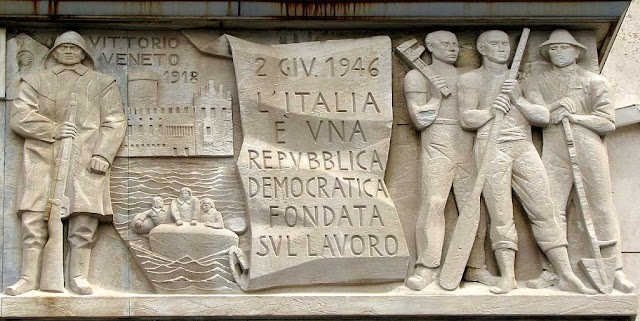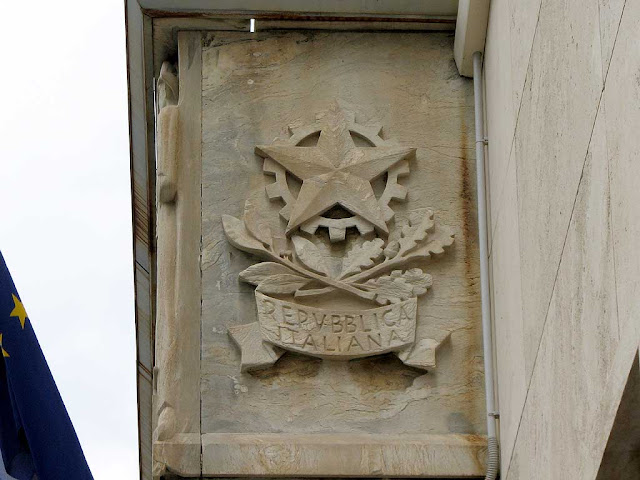 On 16 March 1606, Ferdinando I de' Medici appointed Bernadetto Borromei as the first “Gonfaloniere” of Livorno, since then officially recognized as a “città” (city).
On 16 March 1606, Ferdinando I de' Medici appointed Bernadetto Borromei as the first “Gonfaloniere” of Livorno, since then officially recognized as a “città” (city). The building of a ship symbolizing the already thriving local shipyards as an important resource for the newborn city.
The building of a ship symbolizing the already thriving local shipyards as an important resource for the newborn city. In 1613, under the rule of the Grand Duke Cosimo II, the galleys of the Knight of Saint Stephen, commanded by Jacopo Inghirami, conquered Acliman, freeing 238 enslaved christians and capturing 300 “infidels”.
In 1613, under the rule of the Grand Duke Cosimo II, the galleys of the Knight of Saint Stephen, commanded by Jacopo Inghirami, conquered Acliman, freeing 238 enslaved christians and capturing 300 “infidels”. The coat of arms of the House of Savoy, under which Italy was united as a nation. Livorno has already been annexed to the Kingdom of Sardinia, since 1859. On 20 September 1870 some “Bersaglieri” entered Rome through the “Porta Pia breach”, completing the unification of Italy. Steam powered boat were being built in the shipyards of Livorno.
The coat of arms of the House of Savoy, under which Italy was united as a nation. Livorno has already been annexed to the Kingdom of Sardinia, since 1859. On 20 September 1870 some “Bersaglieri” entered Rome through the “Porta Pia breach”, completing the unification of Italy. Steam powered boat were being built in the shipyards of Livorno. On the left the Cathedral of San Giusto in Trieste and the Castle of Buonconsiglio in Trento. The annexation of two cities was the last step toward the unity of Italy, after the First World War. The soldier simbolizes the participation of the Livornesi to the war. The first article of the Republican Constitution of 1946 is shown in the middle, along with workers of various trades.
On the left the Cathedral of San Giusto in Trieste and the Castle of Buonconsiglio in Trento. The annexation of two cities was the last step toward the unity of Italy, after the First World War. The soldier simbolizes the participation of the Livornesi to the war. The first article of the Republican Constitution of 1946 is shown in the middle, along with workers of various trades. The Italian coat of arms with a glimpse, outside the panel, of the blue European flag.
The Italian coat of arms with a glimpse, outside the panel, of the blue European flag.Livorno Story (Part 1 of 2)
See also:

22 comments:
What a beautiful city! I enjoy looking at your posts.
From Florida, USA
What a story these panels tell! Livorno has quite a history and it's fascinating.
Thanks for sharing all of these photos and especially for your commentary!
What a wonderful way of telling a story. Even though there are few words, the pictures are in Italian, so thanks for interpreting what all those Italians were up to.
Such interesting interpretation in art of this history. Thank you for telling and showing us the story of Livorno.
I love these wonderful carvings. It's such a nice way to tell a story.
Great post!
this is wonderful and such s story. you have to wonder why we have lost such complexity and symbolism in historical artwork today. Contemporary murals generally do not contain this much detail. Of course today we have the internet whereas in olden days, people came to the city to learn and read stories through images. I started a series ion my site today from my photography tour to the slot canyon and Vermillion Cliffs. It was quite an interesting and education trip. Also, if you like travel photos, we have posted action photos from Buenos Aires, Argentina on our travel photo site, www.vivalavoyage.com. Happy Monday!
Gee, U R smart! Someday when I make it 2 Livorno, I'll ask U 2 B the tour guide!
Lots of history - the stone will carry the story for a long time. Nice effort to "cut in stone" the specific version of the Italian perspective on what happened.
I have found, in both France and in Italy, that reliefs of this type are jam-packed with information if one just knows how to read the images right!
One thing though: I wonder how the population of Livorno keeps pace. In all the panels, not one image of a female of the species ahh ... yes yes yes - there is ... today's post, image 3 RHS, mother and child.
Phew ...
Fascinating history of the city - you guys have a past. Are t5he shipyards still functioning?
This is simply beautiful, and your presentation is so interesting. What an amazing piece of heritage this is for Livorno and for all people interested in history and art. These two posts are spectacular.
These panels bring history and art at the same time!Wonderful post dear friend and very informative, like the previous one!
Thanks for sharing!
Léia
...a democratic republic founded on labour...
Reading incriptions can be interesting. I once attended a tour where the guide pointed to a stone and said that it was raised in the honour of workers who built a certain railroad. Upon reading I noticed that the stone was in fact a tribute to the work. Not the workers.
They don't make anything like this anymore, anywhere. It's as though the building is speaking.
Is there another Italian blog? I wonder why this blog is not also simultaneously written in Italian because I think the local inhabitants would be very interested in such a precise & practical presentation of their history.
Wow, I wish I had seen these panels when I was there. They are certainly interesting, incredibly carved and your history lesson was terrific. Livorna is a fascinating city and you have really added to my understanding of how it came about.
Your photos are perfect. Thanks!!
This is really interesting. I love story-telling statues/engravings. I saw something similar in Koblenz, Germany... now where are those photos...
Wonderful history lesson and great carving shots to go with! These two posts are fantastic! Well done, VP!
Great way of presenting history. Terrific posts!
Love it! Thank you for continuing the story. Very interesting!
Very, very interesting and impressive story wall
Post a Comment